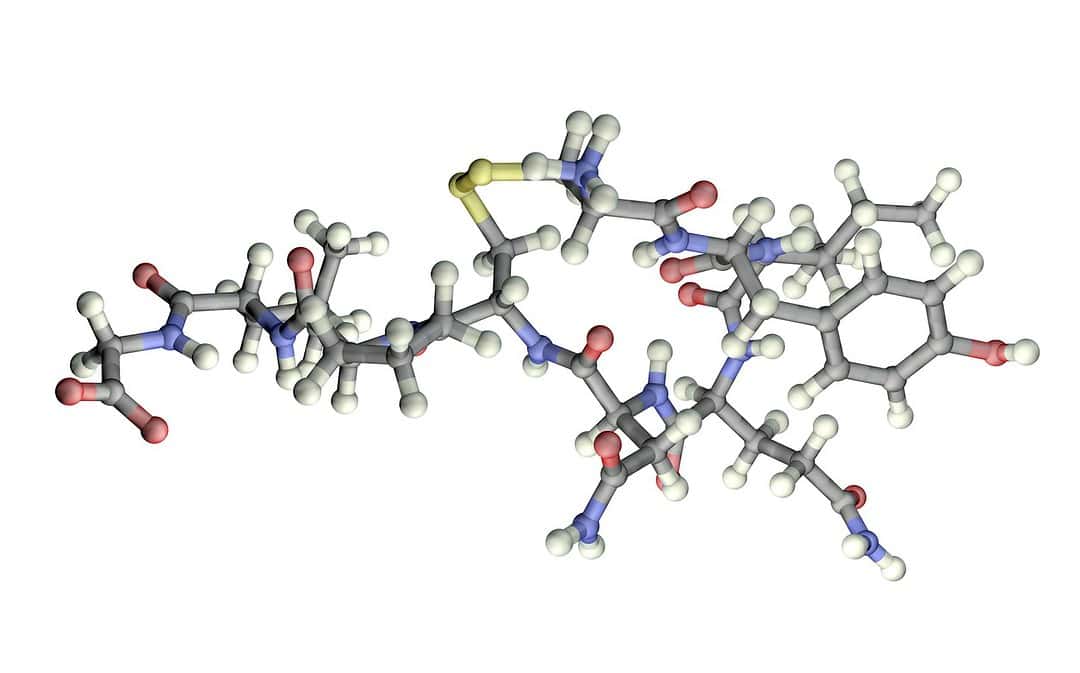Oxytocin is a naturally occurring cyclic peptide hormone composed of nine amino acids. It mainly acts as a neurotransmitter in the brain and is secreted by the pituitary gland.(1) The synthetic form of Oxytocin, called Recombinant Oxytocin, is also a cyclic nonapeptide analogous to the naturally occurring peptide. (2)
Synthesized by the hypothalamus, the compound is secreted and stored in the posterior pituitary gland and is later released upon hormonal stimulation.(3)
Oxytocin appears to work through a positive feedback mechanism. This means that the hormone peptide’s initial secretion may further release the peptide in higher concentrations and with higher intensity. Both synthetic and natural forms of the peptide appear to work through the exact mechanism causing a similar response in the female reproductive system.
Research in the Oxytocin Peptide
Oxytocin is derived from a Greek word where ‘Oxus’ means swift, and ‘tokos’ means childbirth. As indicated by its name, the peptide has been a regular experimental agent in studies on birth and labor.
“Oxytocin is indicated and approved by the FDA for two specific time frames in the obstetric world: antepartum and postpartum. In the antepartum period, exogenous oxytocin is FDA-approved for strengthening uterine contractions with the aim of successful vaginal delivery of the fetus. There are three situations during the antepartum period, which indicate the use of oxytocin. These include mothers with preeclampsia, maternal diabetes, premature rupture of the membranes, mothers with inactive uteri that require stimulation into labor, and mothers with inevitable or incomplete abortions in their second trimester. Postpartum, oxytocin is FDA-approved when it is time to deliver the placenta during the third stage of labor and control postpartum hemorrhage.” (3)
Once in the system, the peptide appears to bind with the G-protein coupled receptors found in the uterus membrane, potentially increasing intracellular calcium levels. This calcium secretion then causes uterine contractions. Once the uterine contractions begin, it may stimulate the release of the compound, leading to higher frequency and intensity of the contractions via a positive feedback mechanism.
A clinical study (4) was conducted to determine the rate of cesarean delivery after discontinuing the compound exposure once active labor began (5 cm cervical dilation) compared to subjects where Oxytocin was introduced to the maintenance level as determined in the clinical trial study protocol. The study suggested that the percentage of cesarian deliveries was much higher if Oxytocin exposure was stopped partway versus those who were given the peptide until birth. This result suggests that Oxytocin may positively induce labor.
The peptide may potentially cause contraction of the myoepithelial cells found in the alveolar ducts of the female breasts. These contractions stimulate milk ejection from these alveolar ducts into the larger sinuses, thereby expelling milk. The positive feedback mechanism may work here, and initial milk expulsion may stimulate further peptide release and continuous milk release. (3)
A clinical study was conducted(5) and found that of the test subjects who were successfully breastfeeding, 27% were supplemented with concentrations of Oxytocin, whereas only 14% were not. While further research is needed, the evaluation suggests that Oxytocin has the potential to positively affect lactation and help to increase breastfeeding duration.
Some additional properties being researched:
- Oxytocin may possess vasodilatory potential, which can help improve cardiac function and tone in the heart muscles. A study(6) suggested that Oxytocin may help regulate the blood pressure and heart rate during pregnancy.
- Another neurological ailment in which Oxytocin impact has examined is Schizophrenia. Schizophrenia is a chronic neurological disorder characterized by hallucinations, impaired speech, and lack of motivation. Schizophrenia is mainly caused due to an imbalance in Oxytocin levels; therefore, exposure to supplemental concentrations of the peptide may help maintain Oxytocin at equilibrate levels.(8)
- It also carries potential within the context of research models of obsessive-compulsive disorder (OCD). However, in clinical research studies investigating this potential observed increased cases of memory disturbances and instances where test subjects showed reduced sodium levels in blood plasma and decreased osmolality. Therefore, a clear understanding is yet to be established, and additional studies are to still in process to determine the breadth of impact.
NOTE: These products are intended for laboratory research use only. This peptide is not intended for personal use. Please review and adhere to our Terms and Conditions before ordering.
References:
- National Center for Biotechnology Information. “PubChem Compound Summary for CID 439302, Oxytocin” PubChem, https://pubchem.ncbi.nlm.nih.gov/compound/Oxytocin
- Recombinant Oxytocin (Code C724). https://ncit.nci.nih.gov/ncitbrowser/ConceptReport.jsp?dictionary=NCI_Thesaurus&ns=NCI_Thesaurus&code=C724
- Osilla EV, Sharma S. Oxytocin. [Updated 2021 Jul 27]. In: StatPearls [Internet]. Treasure Island (FL): StatPearls Publishing; 2021 Jan. https://www.ncbi.nlm.nih.gov/books/NBK507848/
- Induction of Labor with Oxytocin: When Should Oxytocin be held? https://clinicaltrials.gov/ct2/show/results/NCT00957593
- Gomes M, Trocadero V, Carlos-Alves M, Arteiro D, Pinheiro P. Intrapartum synthetic oxytocin and breastfeeding: a retrospective cohort study. J Obstet Gynaecol. 2018 Aug;38(6):745-749. Epub 2018 Mar 9. https://pubmed.ncbi.nlm.nih.gov/29523035/
- Rabinow, S., Hjorth, U., Schönbeck, S. et al. Effects of Oxytocin and anesthesia on vascular tone in pregnant women: a randomized, double-blind placebo-controlled study using non-invasive pulse wave analysis. BMC Pregnancy Childbirth 18, 453 (2018). https://bmcpregnancychildbirth.biomedcentral.com/articles/10.1186
- Cochran, D. M., Fallon, D., Hill, M., & Frazier, J. A. (2013). The role of Oxytocin in psychiatric disorders: a review of biological and therapeutic research findings. Harvard review of psychiatry, 21(5), 219–247. https://doi.org/10.1097/HRP.0b013e3182a75b7d
- Guastella AJ, Einfeld SL, Gray KM, Rinehart NJ, Tonge BJ, Lambert TJ, Hickie IB. Intranasal Oxytocin improves emotion recognition for youth with autism spectrum disorders. Biol Psychiatry. 2010 Apr 1;67(7):692-4. https://pubmed.ncbi.nlm.nih.gov/19897177/
- Oxytocin Injection. https://medlineplus.gov/druginfo/meds/a682685.html
- Cochran, D. M., Fallon, D., Hill, M., & Frazier, J. A. (2013). The role of Oxytocin in psychiatric disorders: a review of biological and therapeutic research findings. Harvard review of psychiatry, 21(5), 219–247. https://doi.org/10.1097/HRP.0b013e3182a75b7d

